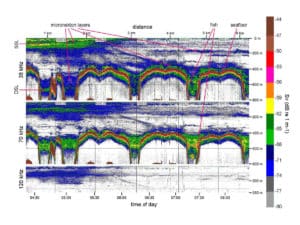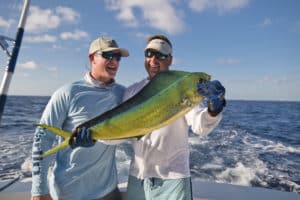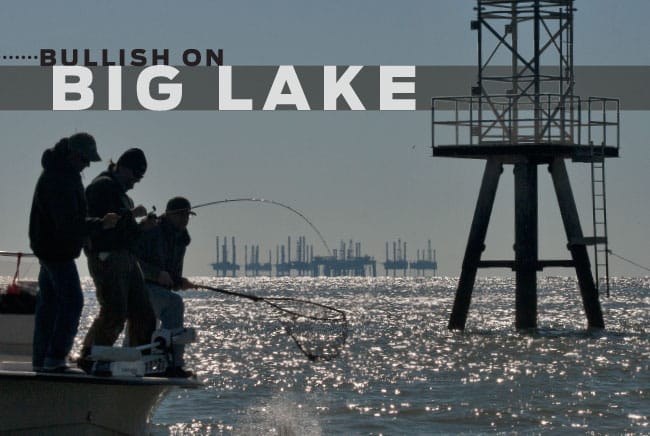
bullish big lake
The conditions were all wrong. The season’s first big cold front — a bit ahead of schedule for late October — decided to come roaring south on the same day I went flying west, and the two of us met up in the southwestern corner of Louisiana.
I don’t generally care to keep company with blustery types, but there it was.
Of course, I’d heard about “Big Lake,” as Calcasieu Lake is known locally, and its world-class fishing for trophy trout and abundant redfish. Some pretrip research had also made clear that Calcasieu is at its best when conditions are calm. With the wind predicted to blow from the north at 15 to 20 knots the next day, we weren’t going to see much calm weather. A north w
ind announcing a cold front usually isn’t a harbinger of good things in most inshore fisheries either.
But we had to play the hand we were dealt, and the next couple of days offered instructive — if chilly — proof of the opportunity that awaits anglers at Calcasieu.
Diving Birds Promise Trout
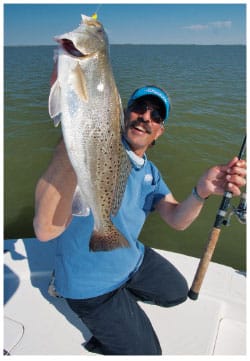
| |The author enjoys a late-afternoon gator trout, for which Big Lake’s famed.|
Just as the sun began showing over the salmon-orange horizon, I was hunkered down in front of the console of Capt. Guy Stansel’s bay boat in the 35-knot wind, biting thanks to temperatures too close to the 30s for South Texas in midautumn.
Guy was heading us north, to the upper end of Big Lake. Before we left the dock at Hackberry Rod & Gun, on the upper western shore of the lake, Guy had done a good job of keeping down the expectations of his anglers, Gerry Benedicto (Seaguar’s brand manager) and me.
Guy assured us that after the leading edge of the front had passed through in another day or two, we’d likely see one of Big Lake’s hallmarks: flocks of gulls and terns wheeling and diving over shrimp. “In fact, once a cold front has gone through, in spring and fall, you’ll see birds working all over,” Guy said. “The cold flushes the shrimp out of the marsh and into the lake.”
And even in the stiff wind, some brave birds had begun forming small flocks, and Guy steered us right toward them, because where there are diving birds, there are trout.
Sure enough, for the next couple of hours, just about any lure we could drop under a few birds would be snatched. We could see shrimp here and there leaping from the café au lait water, four to six feet deep (and typical of most of the lake). The action was fun, but the fish that morning fell short of the “trophy” category.
Still, I could imagine the scene Guy had described when it’s really on here, when — rather than a few, small, isolated bird flocks — you can jump from one huge melee to the next. “You can do that all day long, usually,” Guy said.
I kept waiting to hook something other than trout, since often those “others” predominate in such feeding frenzies — ladyfish, jacks, sailcats, bluefish. But nary a one. That’s another surprising thing about Calcasieu. Guy says that often reds are mixed in with the specks, but it’s rare to hook many other species except in May, when ladyfish can be common.
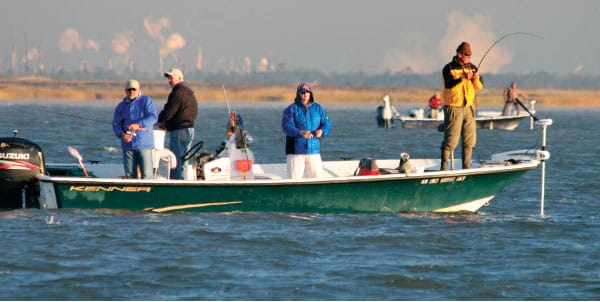
| |Unseasonably cold fall morning on the lake’s northern end slows but doesn’t stop the trout bite.|
Also common in midspring: massive schools of juvenile ribbonfish (cutlassfish). As much as trout like shrimp, they seem to have a particular taste for the silver four- to 10-inch eellike fish. “That’s a great time to get some really big trout,” Guy says.
“Really big” is always a relative term. In Big Lake, 10-pounders are present but rare, according to Capt. Kirk Stansel, Guy’s brother. “On the other hand,” Kirk says, “trout from six to eight pounds are pretty common.” Spring and summer are prime times to get them.
Bull Reds and a Peek at Pinky
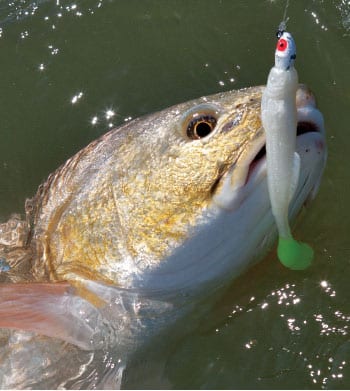
| |Once the shallow waters of West Cove warmed up, redfish like this began competing with trout for our paddle-tail soft baits.|
While trout were about on that chilly morning, nary a red did we see. Figuring the shallows usually so productive for reds wouldn’t have much to offer that day, Guy ran us down the 15 or so miles from the north end of Big Lake to the south end, entering the Lake Charles ship channel that connects to the Gulf of Mexico a few miles farther south. There the jetties mark Calcasieu Pass, providing the only access into the lake.
En route, we got a glimpse of a local celebrity — “Pinky,” the rare albino bottlenose dolphin that lives in the lake. There’s no missing Pinky’s distinctive, shiny, pinkish-white body.
Some other boats from Hackberry Rod & Gun were already anchored or rafted up around the end of the west jetty — and already hooking up.
This wasn’t sight-casting or working lures in shallow water. It wasn’t finesse fishing for school-size reds. This was about dropping live or cut bait to bottom, 18 or so feet down in the roiling muddy water, hooking up and hanging on. The reds were bullish, averaging 15 to 30 pounds, and very willing.
As the tide changed, the bite waned and we headed back up the lake.
Lousy with Flounder
The next day dawned bright and clear, but with the breeze brisk enough again to make us hide our faces inside neck gaiters. This day’s Stansel, Capt. Kirk (well, that is his name), guided Mark Davis — then with Bomber Saltwater Grade lures — and me to a point of land not far north of the jetties. We anchored (along with a couple of other Rod & Gun boats) a short cast off the gravelly shore.
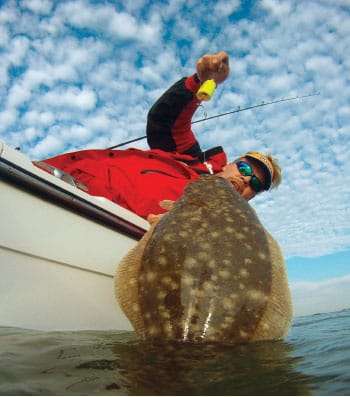
| |The third leg of the Big Lake inshore slam is hoisted in by Mark Davis, a longtime Calcasieu enthusiast.|
The target was neither trout nor redfish, but the third item on the usual slam list: flounder
The south-facing point offered some protection from the breeze as all anglers started casting almost to the water’s edge, most with live shrimp hooked to a quarter-ounce jig head, though a few used soft plastics. Once we all had figured out that you almost couldn’t fish your offering too slowly, a fish — or at least an opportunity for one — came on every cast. The flatties ran two to three pounds
Kirk had said this would be a tide bite and, sure enough, once the incoming tide approached dead high, the fish left or developed lockjaw. Either way, few among the group complained: Most who wanted a limit (of five) had that, and many had begun releasing many more flounder early on.
With no reason to linger, we picked up and ran to the West Cove, a large extension of the lake at its southwest corner, hoping to get in on some of the fast shallow-water action that Big Lake is famous for. For a while, we didn’t see a sign of that.
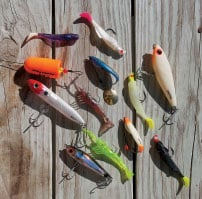
| |Some of his go-to lures for these waters are shown above. A soft bait under a Bomber Paradise Popper often outfishes everything else.|
Then, in the afternoon, the wind finally backed off, the sun warmed the waters, and a few birds started working. Suddenly it was happening — after picking off the occasional trout, we began catching them at a good clip, along with frequent reds. And in short order, all three of us had inshore slams for the day.
While I had success on various lures and soft plastics, Davis had the real winning combo: one of Bomber’s Paradise Poppers with a quarter-ounce jig and plastic tail suspended about 18 inches beneath. The trick called for giving the float a good pop or two, then a really long pause. That pause, almost always, was the moment when a trout or red would pounce on the tail. Suddenly, the popper would be yanked under, and it was game on.
Teeming With Bait
The productivity of Calcasieu amazed me — the supply of shrimp, mullet and menhaden seems to be endless. There’s some irony in that, since the lake is far removed from its natural state. Industrial development of the Calcasieu estuary began nearly a decade ago, when large-scale oil refineries and chemical plants began to line its shores. Many major industries are based around this watershed.
Most natural estuaries in this region tend to be very shallow, as is much of Big Lake; in fact, it’s mostly an extensive marsh. But where the ship channel cuts through it — dredged out decades ago by the U.S. Army Corps of Engineers — depths range from 45 to 50 feet. Occupying much of the 25 or 30 miles separating Calcasieu and Sabine Lake to the west is the Sabine National Wildlife Refuge.
A very short run offshore from the pass sit several oil rigs, known as “short rigs,” that offer fast action from redfish and various coastal pelagics such as tripletail, Spanish mackerel, cobia and jacks in the summer.
I had to fly out after two days, but I got the full report from those in our group who were able to stay for day three. Naturally, that was when the warmer weather and stable barometer had the fish really snapping.
Having experienced Big Lake for a couple of days when conditions weren’t really right, I can only imagine what the action’s like there when all the stars are aligned. Obviously, I’ve got to get back and find out.
A Visit to Lake Calcasieu
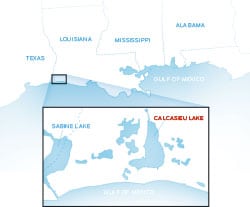
Hackberry Rod & Gun has been putting anglers on fish (particularly gator-class trout) and hunters on ducks in fall since 1975. The large facility (with 50 beds) offers a boat ramp, covered moorage and, of course, guide services. One of its most popular options is something called the Night Stalker — a 44-foot aluminum boat purpose-built to carry six anglers out on the lake after dark for eight-hour night-fishing trips. Its six 1,500-watt underwater lights attract teeming bait and predators. For information, visit hackberryrodandgun.com or call 888‑762‑3391.
Many visitors drive in either from the east (New Orleans, four hours) or the west (Houston, two-and-a-half hours) on Interstate 10. Another option is to fly to Lake Charles; that puts you a little more than a half-hour away, though you’ll still need to rent a car.
Fishing on Big Lake can be good any time of the year, though fall and spring are tops. Note that in late fall, Hackberry Rod & Gun focuses on duck hunting until that season ends.
For specifics of timing your fishing trip, see our Web-extra Calcasieu Lake angling calendar from texasweekendangler.com at sportfishingmag.com/biglakecalendar.

